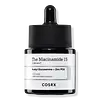What's inside
What's inside
 Key Ingredients
Key Ingredients

 Benefits
Benefits

 Concerns
Concerns

No concerns
 Ingredients Side-by-side
Ingredients Side-by-side

Water
Skin ConditioningGlycerin
HumectantC12-15 Alkyl Benzoate
AntimicrobialAmmonium Acryloyldimethyltaurate/Vp Copolymer
Squalane
EmollientTocopheryl Acetate
AntioxidantPhospholipids
Skin ConditioningDipeptide Diaminobutyroyl Benzylamide Diacetate
Skin ConditioningSh-Oligopeptide-1
Skin ConditioningDipeptide-2
Skin ConditioningN-Prolyl Palmitoyl Tripeptide-56 Acetate
Skin ConditioningPalmitoyl Tetrapeptide-7
Skin ConditioningPalmitoyl Hexapeptide-12
Skin ConditioningPalmitoyl Tripeptide-1
Skin ConditioningCeramide Ng
Skin ConditioningLeuconostoc/Radish Root Ferment Filtrate
AntimicrobialSodium Hyaluronate
HumectantTribehenin
EmollientHesperidin Methyl Chalcone
AntioxidantSorbitan Laurate
EmulsifyingPentylene Glycol
Skin ConditioningSteareth-20
CleansingPEG-10 Phytosterol
EmulsifyingC18-36 Acid Triglyceride
EmollientC18-36 Acid Glycol Ester
EmollientEthylhexylglycerin
Skin ConditioningCaprylyl Glycol
EmollientPhenoxyethanol
PreservativeBenzoic Acid
MaskingDehydroacetic Acid
PreservativePotassium Sorbate
PreservativeWater, Glycerin, C12-15 Alkyl Benzoate, Ammonium Acryloyldimethyltaurate/Vp Copolymer, Squalane, Tocopheryl Acetate, Phospholipids, Dipeptide Diaminobutyroyl Benzylamide Diacetate, Sh-Oligopeptide-1, Dipeptide-2, N-Prolyl Palmitoyl Tripeptide-56 Acetate, Palmitoyl Tetrapeptide-7, Palmitoyl Hexapeptide-12, Palmitoyl Tripeptide-1, Ceramide Ng, Leuconostoc/Radish Root Ferment Filtrate, Sodium Hyaluronate, Tribehenin, Hesperidin Methyl Chalcone, Sorbitan Laurate, Pentylene Glycol, Steareth-20, PEG-10 Phytosterol, C18-36 Acid Triglyceride, C18-36 Acid Glycol Ester, Ethylhexylglycerin, Caprylyl Glycol, Phenoxyethanol, Benzoic Acid, Dehydroacetic Acid, Potassium Sorbate
 Reviews
Reviews

Ingredients Explained
These ingredients are found in both products.
Ingredients higher up in an ingredient list are typically present in a larger amount.
Ethylhexylglycerin (we can't pronounce this either) is commonly used as a preservative and skin softener. It is derived from glyceryl.
You might see Ethylhexylglycerin often paired with other preservatives such as phenoxyethanol. Ethylhexylglycerin has been found to increase the effectiveness of these other preservatives.
Pentylene glycol is typically used within a product to thicken it. It also adds a smooth, soft, and moisturizing feel to the product. It is naturally found in plants such as sugar beets.
The hydrophilic trait of Pentylene Glycol makes it a humectant. As a humectant, Pentylene Glycol helps draw moisture from the air to your skin. This can help keep your skin hydrated.
This property also makes Pentylene Glycol a great texture enhancer. It can also help thicken or stabilize a product.
Pentylene Glycol also acts as a mild preservative and helps to keep a product microbe-free.
Some people may experience mild eye and skin irritation from Pentylene Glycol. We always recommend speaking with a professional about using this ingredient in your routine.
Pentylene Glycol has a low molecular weight and is part of the 1,2-glycol family.
Learn more about Pentylene GlycolWater. It's the most common cosmetic ingredient of all. You'll usually see it at the top of ingredient lists, meaning that it makes up the largest part of the product.
So why is it so popular? Water most often acts as a solvent - this means that it helps dissolve other ingredients into the formulation.
You'll also recognize water as that liquid we all need to stay alive. If you see this, drink a glass of water. Stay hydrated!
Learn more about Water